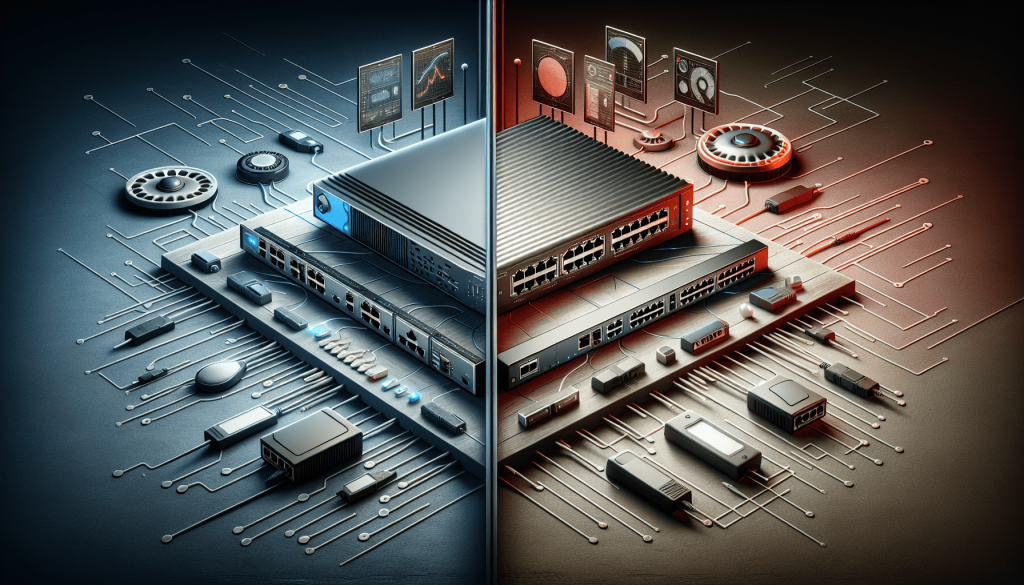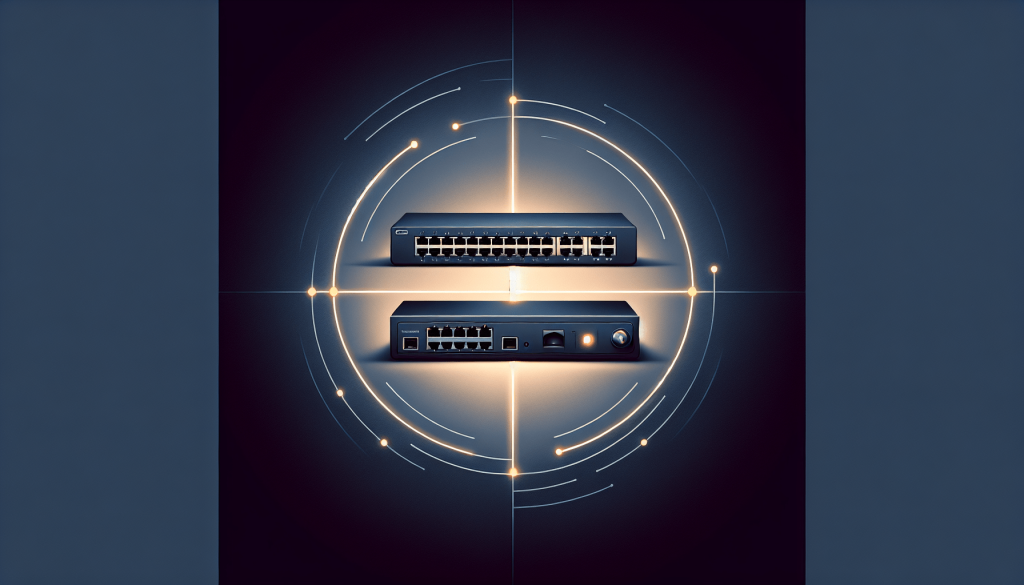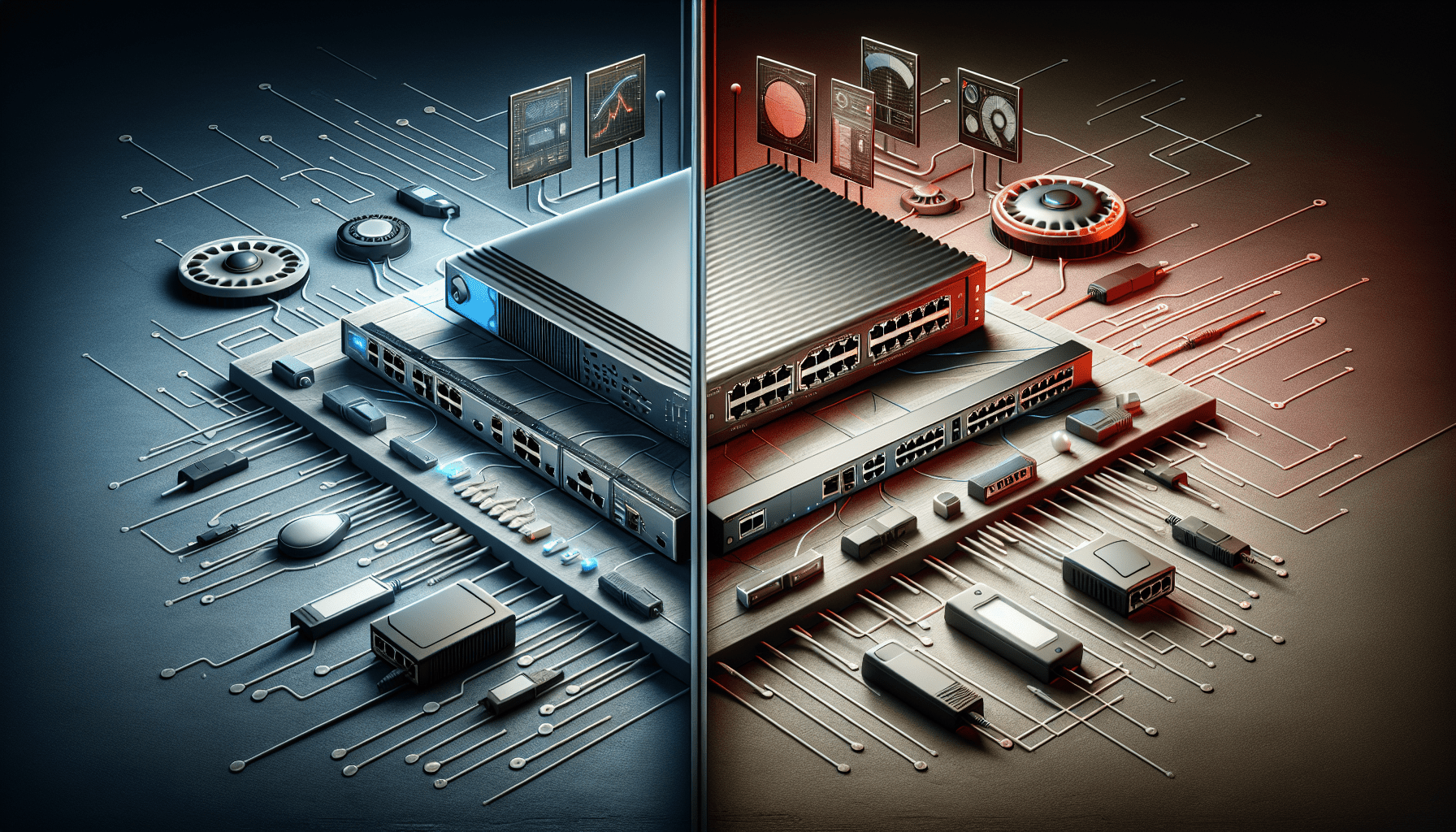If you’ve ever wondered about the differences between a network switch and a hub, you’re in the right place. In this article, we’ll break down the distinctions between these two devices and help you determine which one is best suited for your network needs. So whether you’re a tech enthusiast or simply looking to improve your home network, let’s dive into the world of network switches and hubs.
Definition and Basics
What is a network switch?
A network switch is a device used in computer networks to connect multiple devices, such as computers, printers, and servers, within the same network. It operates at the data link layer of the OSI model and serves as a central hub for transmitting data packets between connected devices. Unlike a hub, a switch intelligently routes the data packets to the appropriate destination based on the MAC (Media Access Control) addresses of the devices.
What is a network hub?
A network hub, on the other hand, is a simpler device that also connects multiple devices in a network. It operates at the physical layer of the OSI model, meaning it simply receives incoming data packets and broadcasts them to all connected devices. A hub doesn’t differentiate between devices and doesn’t have the ability to route data based on MAC addresses.
Functionality
How does a network switch work?
A network switch works by examining the MAC addresses of the devices connected to it. When a data packet is received, the switch reads the source MAC address and determines the destination MAC address. It then forwards the packet only to the device with that specific MAC address. This process is known as “switching” and ensures that data is efficiently delivered only to the intended recipient, reducing unnecessary network traffic.
How does a network hub work?
In contrast to a network switch, a network hub operates in a much simpler manner. When a data packet is received, the hub simply broadcasts it to all connected devices, regardless of the destination MAC address. This lack of intelligence and selective routing means that network traffic can quickly become congested and inefficient. Additionally, since all devices receive every packet, there is a higher risk of collisions and packet loss.

Data Transmission
Transmission in a network switch
In a network switch, data transmission is optimized and efficient. When a device connected to a switch wants to transmit data, it sends the packet to the switch, which then reads the destination MAC address and forwards the packet directly to that specific device. This direct transmission pathway speeds up the delivery of data and reduces network congestion.
Transmission in a network hub
Transmission in a network hub is much less efficient compared to a switch. When a device wants to transmit data, it sends the packet to the hub, which then broadcasts it to all connected devices. Each device connected to the hub must check if the data packet is meant for them, adding unnecessary network traffic and potential delays. This broadcast transmission method can result in slower and less reliable data transfer.
Network Traffic Handling
Traffic handling in a network switch
A network switch can handle network traffic more effectively than a hub. By efficiently routing data packets based on MAC addresses, a switch can direct traffic only to the intended recipient, reducing unnecessary transmissions. This selective transmission improves network performance and reduces the chances of congestion and bandwidth limitations.
Traffic handling in a network hub
In a network hub, traffic handling is much less controlled. All data packets are broadcasted to all connected devices, regardless of the recipient’s MAC address. As a result, network traffic is not optimized, and collisions can occur when two or more devices attempt to transmit data simultaneously. This lack of traffic control can significantly impact network performance and lead to delays and inefficiencies.

Collisions and Packet Loss
Collisions in a network switch
Collisions rarely occur in a network switch due to its intelligent routing capabilities. As the switch determines the destination MAC address of each data packet, it directs the packet only to the intended recipient. This prevents multiple devices from transmitting simultaneously and reduces the likelihood of collisions. The switch’s efficient traffic handling greatly minimizes the chances of data collisions.
Collisions in a network hub
Collisions are more common in a network hub compared to a switch. Since a hub broadcasts data packets to all connected devices, multiple devices may attempt to transmit data simultaneously, resulting in collisions. Collisions impact network performance as the devices involved must retransmit their packets after a collision occurs, leading to delays and decreased efficiency.
Packet loss in a network switch
Packet loss is usually minimal in a network switch. The switch’s intelligent routing allows for efficient delivery of data packets to the intended recipient, reducing the chances of loss. However, in cases of network congestion or hardware malfunctions, packet loss can still occur.
Packet loss in a network hub
Packet loss can be more prevalent in a network hub due to its broadcast transmission method. If multiple devices attempt to transmit data simultaneously, collisions may occur, resulting in packet loss. Since all devices receive all packets, there is a higher chance of congestion and packet loss in a hub compared to a switch.
Scalability and Expandability
Scalability of network switches
Network switches provide high scalability for network expansion. They typically offer multiple ports, allowing numerous devices to be connected simultaneously. Moreover, many switches have additional features like VLANs (Virtual Local Area Networks) and trunking, which enable even greater scalability by segmenting network traffic and facilitating the connection of multiple switches.
Scalability of network hubs
Network hubs, on the other hand, are less scalable than switches. Hubs usually have a limited number of ports, often ranging from four to twelve. When the number of devices in a network exceeds the available ports on a hub, additional hubs must be added, resulting in increased complexity and decreased efficiency.
Expandability of network switches
Network switches offer excellent expandability options. They allow for easy expansion of the network by adding more switches and connecting them to existing switches. This daisy-chaining or cascading of switches enables the creation of larger networks without sacrificing performance or increasing complexity significantly.
Expandability of network hubs
The expandability options for network hubs are limited compared to switches. As hubs cannot connect to one another, adding more hubs to a network can lead to increased network congestion and reduced efficiency. The lack of expandability and the need for additional hubs can quickly become cumbersome and challenging to manage.
Support for Network Segmentation
Network segmentation with network switches
Network switches are well-suited for network segmentation. By utilizing features like VLANs, switches can divide a network into smaller, isolated segments, each with its own set of devices. This segmentation enhances security, improves network performance, and allows for better management and control of network traffic.
Network segmentation with network hubs
Network hubs are not designed for network segmentation. Since they operate at the physical layer and broadcast all data packets to connected devices, they cannot differentiate or segregate network traffic based on specific segments. Therefore, hubs are not suitable for implementing network segmentation strategies.
Reliability and Redundancy
Reliability of network switches
Network switches are generally reliable devices. They are designed to handle high network loads efficiently and offer advanced features like error checking and flow control. Switches can detect errors and automatically resend or discard faulty packets, reducing the chances of data corruption. They also provide redundancy options such as link aggregation and Spanning Tree Protocol (STP), ensuring network availability in case of link failures.
Reliability of network hubs
Network hubs are less reliable compared to switches. Since they provide no intelligence or error checking mechanisms, any error or fault in the network can quickly propagate to all connected devices through the broadcast transmission method. Additionally, hubs lack redundant options, making them more susceptible to single points of failure and network disruptions.
Redundancy in network switches
Network switches offer various redundancy options to ensure network availability. Link aggregation, also known as port trunking, allows multiple physical links to be bundled together, increasing bandwidth and providing redundancy in case of link failures. Spanning Tree Protocol (STP) enables the creation of redundant paths in a network, automatically rerouting traffic to avoid network loops and ensuring network uptime.
Redundancy in network hubs
Network hubs do not provide built-in redundancy options. Since hubs broadcast data to all connected devices, a failure in one hub can impact the entire network. To achieve redundancy in a hub-based network, additional hubs must be added and connected manually, which increases complexity and introduces more potential points of failure.
Security and Management
Security features in network switches
Network switches provide advanced security features. They can implement access control lists (ACLs) to restrict network traffic based on MAC addresses or IP addresses, enhancing network security. Some switches also offer port security features to prevent unauthorized devices from connecting to the network. Furthermore, switch management interfaces often include security measures like remote authentication and encryption protocols.
Security features in network hubs
Network hubs lack advanced security features. Since they only broadcast data packets without any intelligence, they cannot implement security measures based on MAC addresses or IP addresses. Hubs provide no means of preventing unauthorized access, making them less secure compared to switches.
Management options for network switches
Network switches offer extensive management options. They can be configured and monitored through various interfaces, such as command-line interfaces (CLIs), graphical user interfaces (GUIs), or web-based management interfaces. This allows network administrators to control and optimize network performance, implement security measures, and troubleshoot network issues efficiently.
Management options for network hubs
Network hubs typically have limited management options. Since they operate at the physical layer and lack intelligence, hubs offer minimal configuration and monitoring capabilities. Basic settings like port status and link status may be accessible, but overall management options are limited compared to switches.
Cost and Affordability
Cost considerations for network switches
Network switches are generally more expensive than hubs due to their advanced features and intelligent routing capabilities. The cost of a switch can vary depending on factors such as the number of ports, the speed of the ports, and additional features like VLAN support and management options. However, the additional cost is justified by the improved network performance, scalability, and security that switches provide.
Cost considerations for network hubs
Network hubs are more affordable compared to switches. Since hubs operate at a basic level and lack advanced features, they are less expensive to manufacture and purchase. However, it’s important to consider the limitations of hubs in terms of network performance, scalability, and security when evaluating their cost-effectiveness for a specific network environment.
In conclusion, when deciding between a network switch and a network hub, it’s essential to consider the specific requirements and goals of the network. While hubs may be more affordable, they lack the intelligence, efficiency, and reliability of switches. Switches offer superior performance, scalability, security features, and management options, making them the preferred choice for most modern networks.
